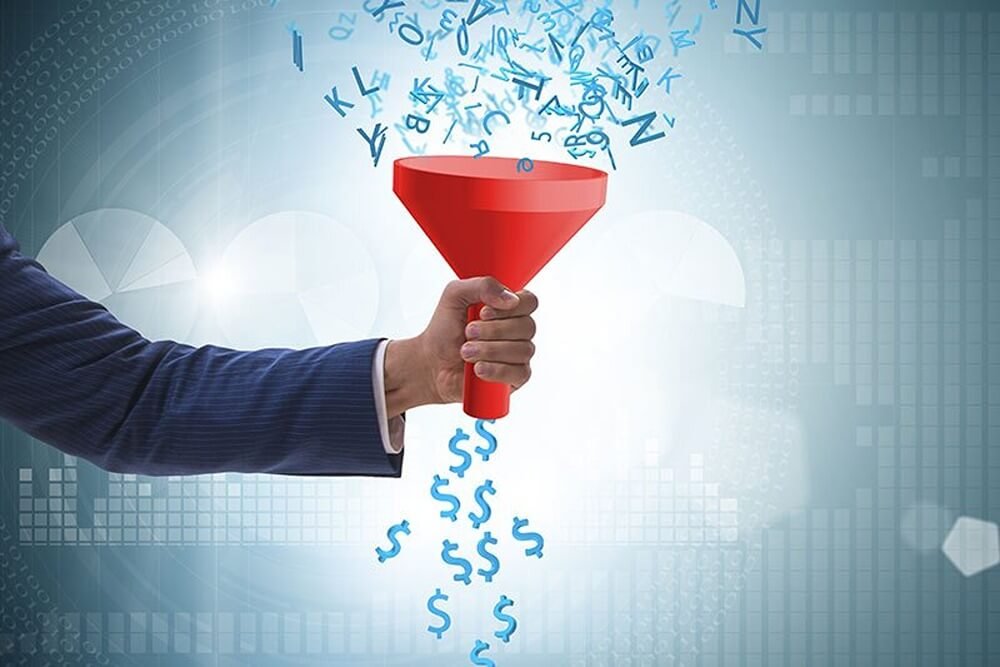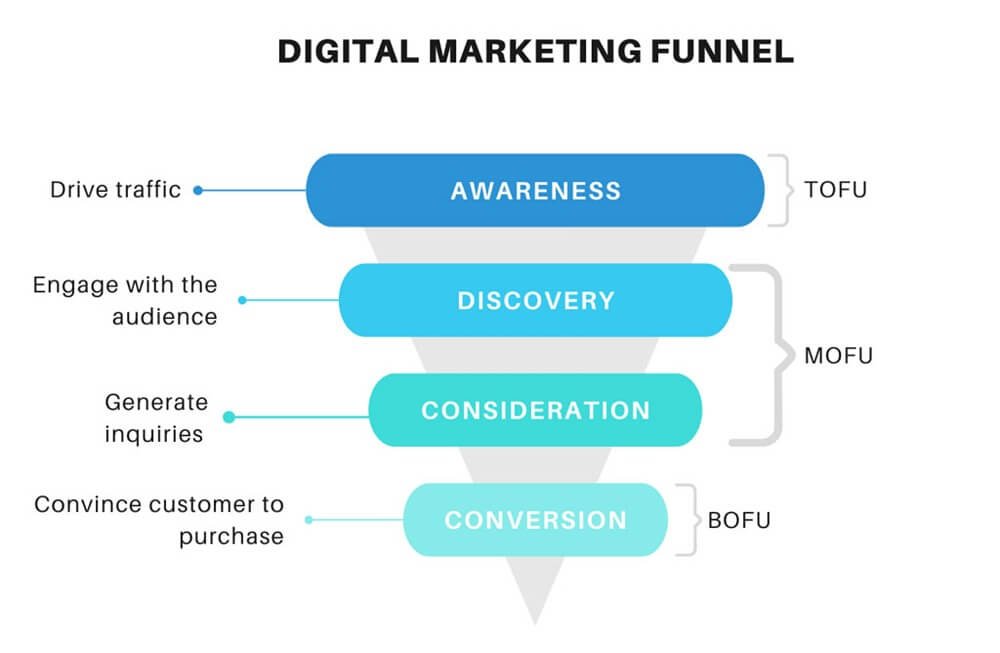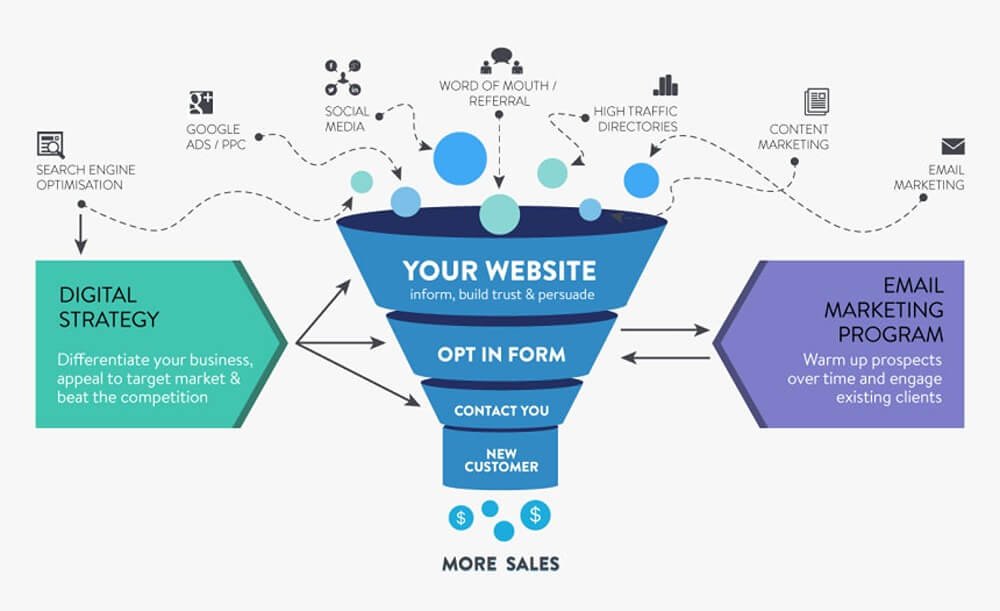You can get frustrated when trying to reach your target audience but have no results. Lack of structure in your marketing initiatives could be why they’re not working out. You can use digital marketing funnels to organize your campaign with the right marketing strategy.

Reaching the ultimate target audience can turn into a daunting task. It’s getting hard to know where to start and even harder to figure out what’s working and what’s not. That’s where the funnel for digital marketing comes in.
A digital marketing funnel strategy helps you organize your marketing initiatives to reach your target audience more effectively.
We here at one of the leading digital marketing agencies in Houston focus on the five major different marketing funnels you can use to reach your target audience!
What Is A Digital Marketing Funnel?
The digital marketing funnel is a company’s process to turn prospects into customers. The funnel comprises five main stages: awareness, interest, consideration, conversion, and customer relationship.
In the Awareness stage, potential customers are first exposed to your brand. This can happen through online ads, social media posts, or other forms of online marketing.
In the Interest stage, customers engage with your brand and learn more about what you offer. They may visit your website, read your blog posts, or watch your product videos. Customers are ready to purchase and choose between different options in the consideration stage.
Finally, customers take the desired action in the Action stage, such as signing up for a free trial or making a purchase.
Digital marketing funnel stages involve a different marketing strategy, and businesses must carefully track customer behavior to move them through the funnel effectively. By using a digital marketing funnel, companies can ensure that they make the most of their online presence and generate maximum ROI.
The goal with the help of digital marketing services in the US, where the digital marketing funnel is concerned, depends on moving potential customers through these stages quickly and efficiently.
How To Create A Digital Marketing Sales Funnel?
Are you looking for a way to improve your conversion rates? If so, you need to create a digital marketing sales funnel. This is the best way to ensure that your website visitors are turning into paying customers.

In order to create a digital marketing sales funnel, you need to first identify your target audience. Once you know who you are marketing to, you can then create content that speaks to their specific needs and pain points.
Once you have built up a rapport with your target audience, you can then start to introduce them to your products or services. However, it is important to remember that not everyone will be ready to make a purchase immediately.
That’s why it’s important to have a well-designed sales funnel in place so that you can gradually move prospects through the different stages of the buying journey. By doing this, you will be more likely to convert leads into customers and boost your bottom line.
What Are The Different Types Of Funnels?
There are different types of marketing funnels in digital marketing, each with its unique purpose and advantages. Perhaps the most common type of funnel is the digital marketing sales funnel, which is used to convert leads into customers.
A typical internet marketing sales funnel will include several steps, such as creating awareness, generating interest, making a sale, and following up with the customer. Other funnels have the lead generation funnel, which generates leads from potential customers, and the brand awareness funnel is used to create awareness for a particular brand or product.
Each type of funnel has its benefits and drawbacks, so choosing the right one for your needs is essential.
Why Is It Required To Strategize Digital Marketing Funnel Stages?
A marketing funnel is an essential tool for any business that wants to thrive in the modern marketplace. By clearly delineating the steps customers take on their journey from awareness to purchase, businesses can ensure that they correctly nurture leads and make the most efficient use of their marketing budget.

A well-designed internet funnel system can help businesses track their progress and identify areas where they need to improve. By taking the time to strategize a comprehensive marketing funnel, companies can lay the foundation for long-term success.
A marketing funnel is a strategic tool used to narrow down a target market and eventually lead them to become paying customers. The top of the funnel has a large pool of potential customers, and as they continue progressing through the funnel, they become more qualified leads until they finally make a purchase.
There are a few things that are important to keep in mind when strategizing a marketing funnel:
- First, identify your ideal customer. Who are you trying to reach? What are their needs and pain points? Once you understand your target audience well, you can craft content and messages that resonate with them.
- Next, consider what kind of content will most effectively move potential customers through the funnel? This could vary depending on your business and audience, including blog posts, e-books, infographics, webinars, or social media content.
- Finally, make sure you have a solid lead capture mechanism to track how potential customers interact with your content. This could be a sign-up form on your website or an opt-in offer for a free e-book or whitepaper.
Once you have placed the pieces correctly, you can see results as potential customers move through the funnel and become more qualified leads. Not sure where to start? Check out these five marketing funnels to help you reach your target audience.
Five Stages Of Digital Marketing Funnels
As a business owner, it’s essential to understand your target market clearly. After all, this is the group of people who are most likely to be interested in your products or services. Once you know your target market, you can begin developing marketing strategies to reach them.
The model consists of five stages:
- Awareness
- Interest
- Consideration
- Conversion
- Customer relationship
In the awareness stage, customers become aware of a problem or need. In the interest stage, they begin to research potential solutions to their problem. They choose a specific product or service to address their need in the decision stage.
Here are the five stages of the digital marketing funnel that can help you reach your target audience:
1. The Awareness Funnel:
In this phase, you’ll focus on getting your brand in front of as many people in your target market as possible. This might involve paid advertising, social media marketing, or PR campaigns.
Awareness is among the most critical stages of the funnel. Customers will only purchase a product or service if they know it exists. To create awareness, businesses must use marketing strategies such as search engine optimization (SEO) , pay-per-click (PPC) advertising, and content marketing
The awareness funnel is the process that consumers go through when they become aware of a new product or service and then decide whether or not to purchase it. Various marketing strategies often influence this process in the digital age. For example, a company may use targeted ads to reach consumers in the early stages of the awareness funnel.
Alternatively, they may use SEO to ensure that their website appears at the top of search results, which can help attract consumers who are further along in the process. Businesses have the option to effectively market their products and services to consumers by understanding the awareness funnel.
The awareness funnel is an essential concept in digital marketing because it can help businesses determine where to focus their efforts.
2. The Interest Funnel:
Once people know your brand, you need to generate interest in what you offer. In digital marketing, the interest funnel is the process that customers go through as they move from an awareness of a product or service to becoming paying customers.
- The first step is to generate leads, which can be done through online ads, search engine optimization, or content marketing.
- Once a lead is generated, the company will try to qualify the information by determining whether the person is interested in the product or service. If the lead is qualified, the company will then try to convert the lead into a customer by making a sale or securing a contract.
- Finally, the company will try to retain the customer by providing excellent customer service and developing long-term relationships. By following this process, companies can effectively reach their target audience and grow their business.
The interesting internet marketing funnel is the process that companies use to identify and target potential customers:
Time is money – and nowhere is this more accurate than in the world of business. Companies are bombarded with a dizzying array of tasks, messages, and deadlines. It gets easy to lose sight of the bigger picture with so much to look after. That’s where tracking the interest funnel can be helpful.
Businesses can quickly identify areas that need improvement by following where leads are coming from and how they progress through the sales process. For example, if many leads drop off at the first stage of the funnel, it may be time to rethink your marketing strategy.
3. The Consideration Funnel
The Consideration Funnel is a powerful tool to help you make better decisions. The idea is simple:
- When you’re faced with a decision, take a moment to consider all of the possible outcomes.
- Rank those outcomes starting from the desirable to the least desirable.
- Choose the most effective option that will lead to the best possible outcome. The Consideration Funnel can apply to all kinds of decisions, large and small.
Businesses can create marketing strategies that target customers at each funnel stage by understanding the Consideration Funnel. For example, businesses might use awareness-stage marketing to raise awareness of a problem that their product can solve.
By understanding how prospects interact with your brand and their needs, businesses can more effectively nurture leads and close deals. The Consideration Funnel can also identify upsell and cross-sell opportunities.
By tracking prospects throughout their journey, companies can better understand their needs and offer them the products and services they’re most likely to convert on. Ultimately, The Consideration Funnel is a valuable tool for businesses of all sizes looking to increase sales and improve customer relationships.
4. Conversion Funnel:
The conversion funnel is a potential customer’s path from awareness to purchase. In the early stages of the funnel, customers are introduced to the product or service through various marketing channels, such as online ads, social media, and email marketing. As they become more familiar with the product, they move further down the funnel, considering its features and benefits and eventually deciding whether to purchase.
A conversion funnel is a valuable tool for digital marketers, as it helps to identify which marketing efforts are most effective at each stage of the buyer’s journey. By understanding the conversion funnel, marketers can fine-tune their campaigns to ensure that they are reaching the right people at the right time.
It is a key component of digital marketing, as it helps businesses track and measure the progress of prospects through the internet sales funnel process. Businesses can tailor their marketing activities to match their needs and priorities by understanding where opportunities are in the funnel. For example, if a prospect is mentioned at the top of the funnel, businesses may focus on raising awareness of their product or service.
If a prospect is further down the funnel, companies may focus on providing more information about their product or service or offering discounts or incentives. By understanding and managing the conversion funnel, businesses can improve their chances of making a sale and achieving their marketing goals.
5. Customer Relationship
The lead conversion is turning a lead into a paying customer. Once you have a lead, the next step is to get closer to your customers. This involves building trust and rapport with them. It would be of help if you showed that you understand their needs and that you need to provide them with the solution they’re looking for.
The best way to do this is by providing them with valuable content that helps them solve their problem. This could be in an eBook, video, or blog post. Once you’ve built trust and rapport with your leads, you can start selling them your product or service.
There are ways to go about this, but one of the most effective is connecting with them. This could also involve something as simple as sending them a handwritten note or card, calling them, or even meeting up with them in person. Whatever you do, the goal is to build rapport and trust and show them you’re interested in more than just making a sale. If you can do that, you’ll be well on your way to closing the deal.
Is A Digital Marketing Funnel A Need For All Businesses?
While digital marketing may be the future wave, that doesn’t mean that it’s right for every business. Just as traditional marketing methods like print ads or television commercials are not appropriate for all companies, neither is a digital marketing campaign.
To decide whether digital marketing is right for your business, it’s essential to consider your target audience, budget, and goals. For example, a complex digital marketing campaign is probably unnecessary if you’re a small business targeting a local market. However, if you’re a larger company with an international audience, investing in a solid digital marketing funnel strategy could benefit you.
Ultimately, pursuing digital marketing should be based on what will work best for your specific business. The digital marketing funnel is one of the essential tools for successful digital marketing.
One way to think about the digital marketing funnel is as a process that moves potential customers through different stages, culminating in a purchase. The first step is getting people to learn about your product or service.
Once people are familiar with your product or service, they might consider whether it’s a good fit for them. At this stage, they will have the option to visit your website or use your app. If they decide to buy from you, they’ll go through the purchase process. If they don’t buy right away, you might try re-targeting them with ads or other strategies.

